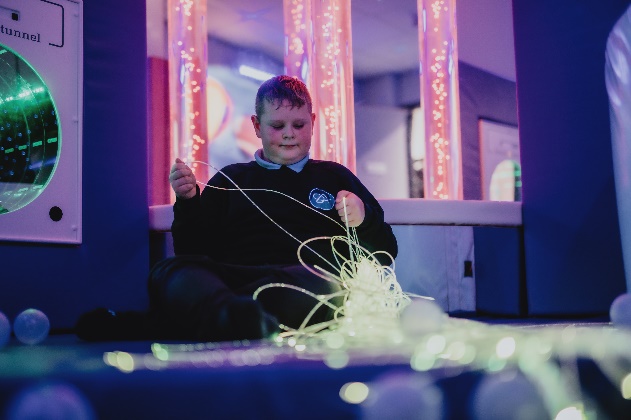Sensory @ Discovery
Discovery’s Sensory Offer
We know that autistic people may experience sensory differences. Some of our young people may be over-sensitive or under-sensitive to specific sights, sounds, smells or textures. This can be a positive thing, but can also cause distress or discomfort.
We believe that by accommodating these needs we increase our student’s ability to access their learning, social interactions and the school day more generally. By teaching young people about their brains and their bodies we prepare them for a future where they can confidently self-advocate.
We use a range of strategies, routines and resources to support our young people and their sensory differences. In class support
We endeavour to make our classroom environments safe, engaging and enabling spaces. In our classrooms you will find:
- Ear defenders
- Fidget toys
- Chewellry
- Weighted shoulder wraps / soft toys
- Tactile adaptations e.g. soft seating / tactile cushions and rugs
- Soft / dimmed lighting
- Flexible seating e.g. bean bags / standing desks
- Calm / quiet areas

Sensory Room
The sensory room is designed to support children as they develop their ability to relax and regulate. Children who are sensory seeking will find it easier to regulate as they engage with the lights and textures of this unique and state-of-art space.
Sensory Integration Room
The Swing
This resource supports the child to develop a stronger understanding of movement. It also offers a deep calming sensation. Think about a baby in the womb, mothers often sway side to side to get comfy which when the baby is born is often calming in itself. The swing offers the same thing, a sensation of being rocked which we often do to self soothe.
The Cuddle Chair
This offers the sensation of a ‘hug’. A hug is something that makes us feel safe, warm and regulated. For some autistic people this isn’t something they can access as physical touch is something they cannot tolerate. Our chair offers this soothing sensation on their terms. Something that offers dignity and acceptance.
The Body Roller
This provides children with the opportunity to feel deep pressure. The child rolls through the rollers independently and access a sense of calm and relaxation.
Soft Play Room
The soft play room is designed to provide children with proprioception activities. This means sensory input from the large muscle groups (legs and arms) and the spine. The room can also provide some children with vestibular input which means opportunity to balance and move in a coordinated way. Children can burn off a lot of energy in here, and it can act as a safe way to energise a child and ‘wake them up!’.
Sensory Circuits
Sensory Integration is the process by which the brain receives, organises and processes all the information received from the senses.
A sensory circuit is a form of sensory integration intervention.
It involves a sequence of physical activities that are designed to alert, organise and calm the child. The sensory circuit aims to facilitate sensory processing to help children regulate and organise their senses in order to achieve the ‘just right’ or optimum level of alertness required for effective learning.
Select students engage in Sensory Circuits each morning in order to prepare for learning.
Messy Play
In Lower School we are lucky enough to have a designated ‘messy play’ room. Here students can engage with different textures, colours, smells, tastes and visual stimuli in a safe and structured way.
Engaging children with autism in the right messy play can stimulate their brain, creating neural pathways and improving their sensory processing systems.
It can improve social skills such as communication and cooperation and improve coordination including hand-eye coordination and fine motor skills/gross motor skills.
Sensory Diets & Keyworkers
A small number of our young people have more significant sensory barriers than others. These young people have been allocated a ‘sensory keyworker’ within their staff team. These trusted adults spend most of the school day with our young people and are well-placed to track, adapt and support a flexible, informed and personalised sensory diet.
This might mean planned movement breaks, prompts to use sensory support tools or simply being aware of the challenges presented by certain times in the school day and being there to help.
